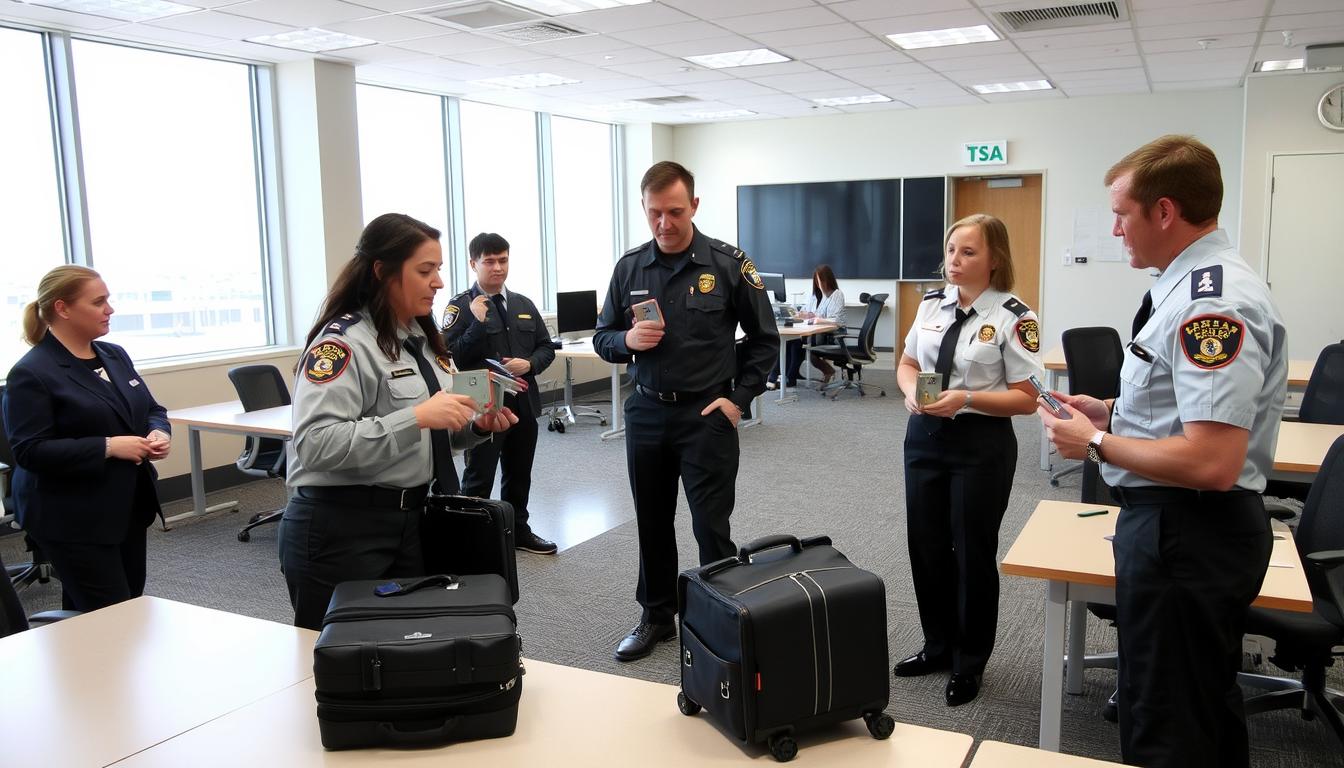The Transportation Security Administration (TSA) has been a cornerstone in enhancing aviation security since its inception after the 9/11 attacks. Did you know that several of the terrorists involved received flight training in the United States, highlighting a significant security vulnerability?
The TSA has since implemented various aviation programs to address such threats. These include the Flight Training Security Program (FTSP), Federal Air Marshal Service (FAMS), and Federal Flight Deck Officer Program, all designed to bolster the security of air travel.
Understanding these programs is crucial for flight training providers and candidates alike, as they play a vital role in ensuring the safety and security of the aviation industry.
Key Takeaways About Aviation Programs :
- The TSA offers various aviation programs to enhance air travel security.
- These programs were largely developed in response to the 9/11 attacks.
- Flight training security is a critical component of TSA’s aviation security strategy.
- Understanding TSA regulations is essential for those in the aviation industry.
- The TSA continues to adapt its programs to address emerging threats.
Overview of TSA’s Role in Aviation Security
With the creation of the TSA, the U.S. government significantly enhanced aviation security, implementing rigorous standards and protocols. The TSA’s primary responsibility is to protect the nation’s transportation systems, ensuring the security of passengers, aircraft, and flight operations.
The TSA’s role involves various measures, including security threat assessments, flight training security programs, and aircraft security protocols. These measures are designed to prevent potential threats and ensure compliance with federal regulations.
The Mission and Mandate of TSA
The TSA’s mission is to protect the nation’s transportation systems, ensuring freedom of movement for people and commerce. To achieve this, the TSA is mandated to implement and enforce security regulations across the aviation industry.
Beginning in December 2003, a series of legislative actions substantially modified the requirements in the Aviation and Transportation Security Act (ATSA). The Vision 100-Century of Aviation Reauthorization Act transferred the function of vetting candidates from the Attorney General to the Secretary of the Department of Homeland Security (DHS).
This change required DHS to issue an Interim Final Rule (IFR) to implement additional requirements, including authority to charge for the costs of conducting required vetting. The TSA’s mandate now includes both initial and recurrent training security programs.
Evolution of Aviation Security Since 9/11
Following the September 11 attacks, aviation security underwent a dramatic transformation with the creation of the TSA and the implementation of enhanced security measures across the aviation system. Legislation like the ATSA and the Vision 100-Century of Aviation Reauthorization Act fundamentally changed how flight training and aviation security are regulated.
- The evolution of aviation security includes the transfer of vetting responsibilities from the Department of Justice to the Department of Homeland Security, establishing a more centralized approach.
- Understanding this historical context helps explain why current aviation programs have specific requirements for both U.S. citizens and non-U.S. citizens seeking flight training.
- The TSA’s approach to aviation security continues to evolve based on emerging threats, technological advancements, and lessons learned from security incidents.
As a result, the TSA remains committed to enhancing aviation security, ensuring the safety of passengers and aircraft, and adapting to new challenges in the ever-changing landscape of flight operations.
Aviation Programs – Transportation Security Administration Offers

To enhance aviation security, the TSA implements a variety of programs and initiatives. These programs are designed to protect the aviation industry from potential threats and ensure the safety of air travel.
The TSA’s aviation security programs are multifaceted, addressing various aspects of security. One key program is the Flight Training Security Program (FTSP), which is crucial for ensuring that flight training candidates undergo thorough security checks.
Flight Training Security Program (FTSP)
The FTSP is a critical component of the TSA’s aviation security measures. It involves the screening of individuals seeking flight training to prevent potential security threats. The program requires flight schools and training providers to vet candidates before they begin their training.
As part of the FTSP, flight training providers must comply with specific regulations, including the submission of candidate information for security threat assessments. This process helps to identify potential security risks and prevent them from accessing flight training.
The FTSP is an essential layer of security in the aviation industry, ensuring that individuals with malicious intentions are not able to gain access to flight training.
Federal Air Marshal Service (FAMS)
The Federal Air Marshal Service (FAMS) is another vital component of the TSA’s aviation security efforts. FAMS is responsible for deploying highly trained air marshals on flights to deter and respond to potential security threats.
Air marshals undergo rigorous training to prepare them for a range of scenarios, from hijackings to other security incidents. Their presence on flights provides an additional layer of security, helping to ensure the safety of passengers and crew.
FAMS works closely with other law enforcement agencies and aviation stakeholders to share intelligence and coordinate efforts to protect the aviation system.
Federal Flight Deck Officer Program
The Federal Flight Deck Officer (FFDO) Program is a voluntary program that allows eligible flight crew members to use firearms to defend against potential hijacking attempts or other security threats. Pilots who participate in the FFDO program undergo specialized training in the use of firearms, defensive tactics, and legal policies regarding the use of force.
The FFDO program represents a collaborative approach between the TSA and the commercial aviation industry to enhance flight deck security. By training qualified pilots to serve as the last line of defense for the cockpit, the program provides an additional layer of security for commercial aviation.
FFDOs work in conjunction with other aviation security measures, including reinforced cockpit doors and Federal Air Marshals, to create a comprehensive security system for commercial aviation.
Understanding the Flight Training Security Program
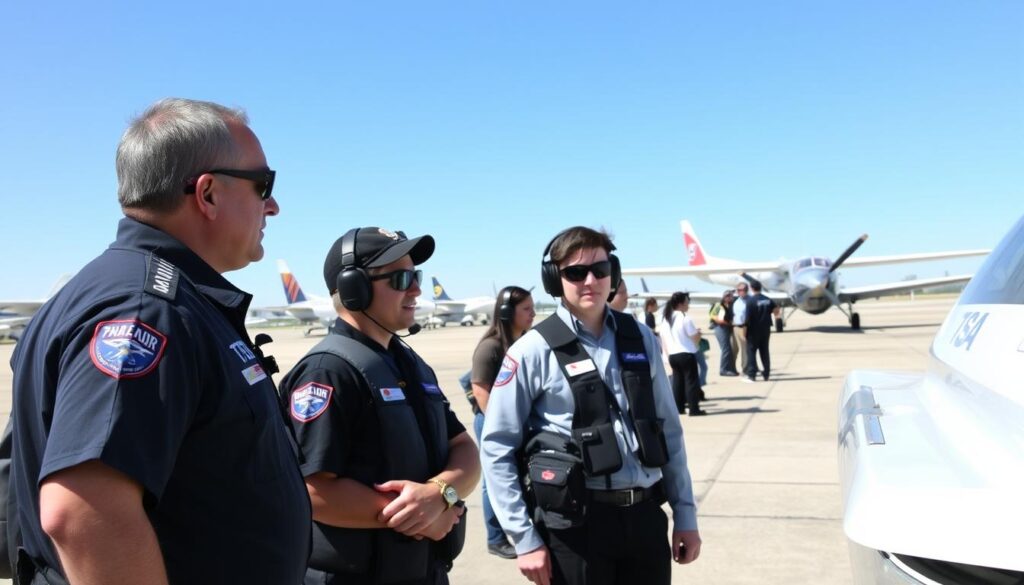
The Transportation Security Administration (TSA) implemented the FTSP to enhance aviation security through rigorous vetting and monitoring of flight training activities. As a flight training provider or candidate, understanding the FTSP is essential for compliance and security.
The FTSP is designed to prevent individuals with malicious intentions from obtaining flight training that could be used to harm people or compromise national security. By regulating and monitoring flight training events, the TSA can better assess potential security risks and take proactive measures to mitigate them.
History and Development of FTSP
The FTSP was established in response to the changing landscape of aviation security, particularly after the events of 9/11. The TSA recognized the need to scrutinize flight training activities more closely to prevent potential security threats.
The program has evolved over time to address emerging security concerns and to improve its effectiveness in identifying and mitigating risks. The TSA continues to refine the FTSP to ensure it remains a robust and relevant component of the overall aviation security framework.
Who Must Comply with FTSP Regulations
Compliance with FTSP regulations is mandatory for flight training providers who offer training that could potentially pose security risks if provided to individuals with harmful intentions. This includes training for various aircraft categories such as airplanes, rotorcraft, powered-lift, and gliders when leading to certain certificates or ratings.
Flight training providers must verify the eligibility of candidates before providing training and notify the TSA as required. The program distinguishes between initial flight training events, which require full security vetting, and recurrent training, which may have modified requirements.
Types of Flight Training Covered Under FTSP
The FTSP covers specific types of flight training that are considered high-risk or sensitive. This includes training that leads to the issuance of a certificate or rating, such as an Airline Transport Pilot certificate or a Commercial Pilot certificate.
Not all aviation instruction falls under FTSP requirements. Certain activities like ground instruction only, flight reviews, or training in aircraft below specified weight thresholds may be exempt. Understanding exactly which training activities are covered helps flight training providers determine when they need to verify candidate eligibility and notify the TSA before proceeding with instruction.
By clarifying the types of flight training covered under the FTSP, providers can ensure compliance with regulations and contribute to the overall security of the aviation system.
Security Threat Assessments for Flight Training
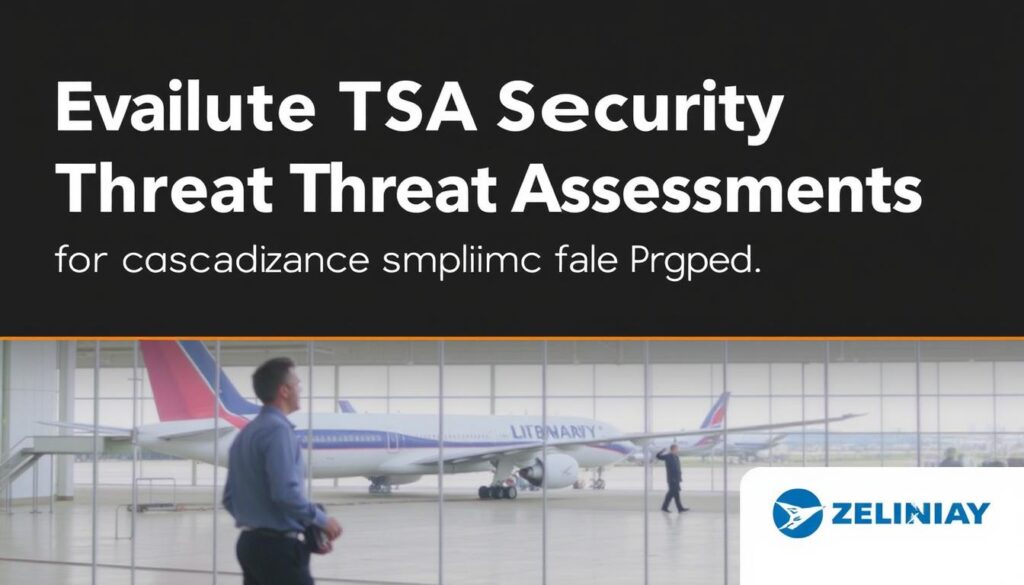
The Transportation Security Administration (TSA) requires security threat assessments for individuals undergoing flight training. This process is crucial for ensuring the security and integrity of the aviation system.
Security threat assessments are a vital component of the flight training process, helping to identify potential security risks. The TSA has implemented a comprehensive program to assess the eligibility of candidates for flight training.
The STA Process Explained
The Security Threat Assessment (STA) process involves a thorough background check on candidates. This includes a review of their personal and professional history to identify any potential security threats.
The STA process is designed to be thorough and efficient, with the TSA working closely with other government agencies to gather and verify information. The process typically involves the submission of required documentation, which is then reviewed and verified by the TSA.
Documentation Requirements for Candidates
Candidates undergoing flight training must provide specific documentation to support their STA. This includes proof of identity, citizenship, and other relevant information.
The TSA has specific requirements for the documentation that must be submitted. Candidates should ensure that they provide all required information to avoid delays in the STA process.
Timeframes and Validity Periods
Security Threat Assessments for flight training have specific timeframes for processing and validity periods. The TSA typically processes standard STA applications within 30 days, although expedited processing may be available in certain circumstances for an additional fee.
Once issued, a Determination of Eligibility for flight training remains valid for a specific period, typically five years. After this period, candidates must undergo a new assessment to continue their training.
The validity period applies across different flight training providers, allowing candidates to train with multiple instructors or schools under a single active STA. Understanding these timeframes helps flight training providers and candidates plan their training schedules and ensure continuous compliance with security requirements.
Requirements for Flight Training Providers
As a flight training provider, you’re required to meet specific TSA regulations to ensure compliance and security. These requirements are designed to maintain the integrity of the aviation industry and prevent potential security threats.
Provider Registration and Compliance
To operate legally, flight training providers must register with the TSA and comply with the regulations set forth in the Flight Training Security Program (FTSP). This involves submitting required information and maintaining accurate records.
Key compliance requirements include:
- Registering with the TSA through the FTSP Portal
- Maintaining accurate and comprehensive records
- Ensuring employees complete security awareness training
Security Awareness Training for Employees
Flight training providers are required to ensure that their employees undergo security awareness training. This training is crucial for maintaining a secure environment and preventing potential security breaches.
The security awareness training covers essential topics such as:
- Recognizing and reporting suspicious activities
- Understanding security protocols and procedures
- Maintaining candidate and training information confidentiality
Recordkeeping and Notification Requirements
Flight training providers must maintain comprehensive records and notify the TSA of certain flight training events. This includes submitting required information through the FTSP Portal.
Required records and notifications include:
- Citizenship verification documents
- Training notifications and candidate details
- Security threat assessment results
The electronic recordkeeping system through the FTSP Portal simplifies compliance by providing a centralized location for maintaining required documentation. Understanding these recordkeeping and notification requirements helps providers avoid compliance issues and potential penalties for regulatory violations.
By maintaining accurate records and notifying the TSA as required, flight training providers can ensure compliance with TSA regulations and contribute to the overall security of the aviation industry.
Requirements for Flight Training Candidates

As you prepare for flight training, understanding the specific requirements for candidates is crucial. The Transportation Security Administration (TSA) has established guidelines to ensure that all individuals undergoing flight training meet certain security standards.
The TSA’s requirements for flight training candidates are designed to enhance aviation security. These requirements differ based on whether you are a U.S. citizen or a non-U.S. citizen.
U.S. Citizens vs. Non-U.S. Citizens Requirements
For U.S. citizens, the process typically involves submitting an application with required documentation, such as proof of citizenship and identification. Non-U.S. citizens, however, must undergo additional screening, including a security threat assessment.
Key differences in requirements include:
- Documentation: U.S. citizens need to provide proof of citizenship, while non-U.S. citizens must provide valid immigration documents.
- Security Threat Assessment: Non-U.S. citizens are subject to a more comprehensive security vetting process.
- Fee structure: The cost for security assessments may vary depending on your citizenship status.
Application Process for Candidates
To apply for flight training, you’ll need to submit your application through the TSA’s online portal. The process involves filling out the required forms, uploading necessary documents, and paying the applicable fees.
It’s essential to ensure that all information provided is accurate and complete to avoid delays in processing.
The TSA will review your application and conduct a security threat assessment if necessary. You may be required to provide additional information or documentation during this process.
Recurrent Training Requirements
For candidates undergoing recurrent flight training, the TSA has specific requirements. Recurrent training includes activities such as refresher courses, proficiency checks, and training in the same category and class of aircraft.
Important aspects of recurrent training requirements:
- If you’ve previously completed a Security Threat Assessment, you may be eligible for expedited processing.
- Non-U.S. citizens must still undergo security vetting for recurrent training, though the process may be streamlined if they have a valid prior assessment.
- You must notify your flight training provider about any previous security assessments to potentially qualify for reduced fees or expedited processing.
Understanding these requirements helps you maintain compliance with aviation security regulations while pursuing your flight training.
Fees and Payment Structure for Aviation Programs
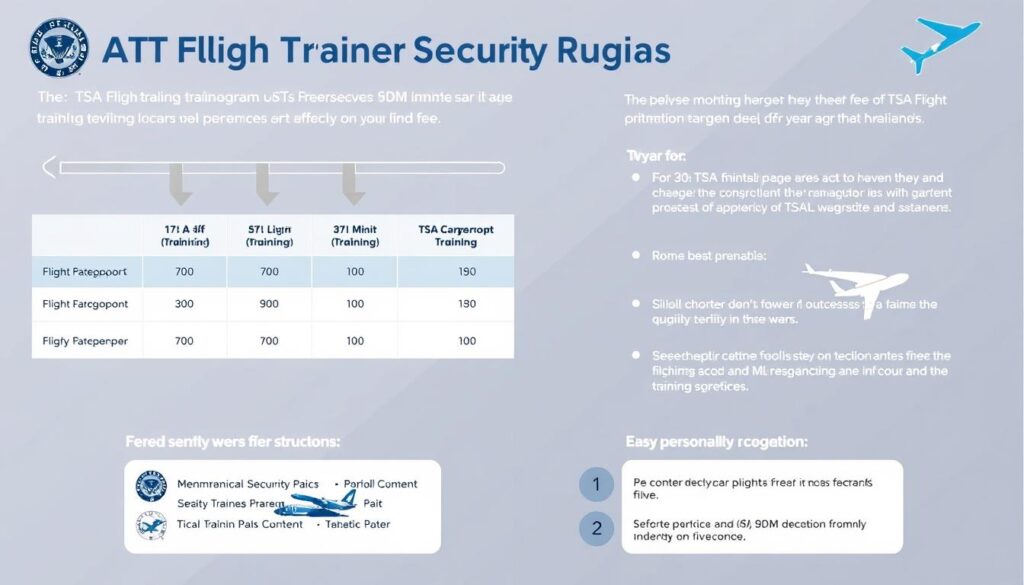
As you navigate the TSA’s Flight Training Security Program, it’s vital to comprehend the fee structure and its implications. The fees associated with this program are designed to support the critical security functions that ensure the safety of aviation operations.
The TSA incurs various costs in performing Security Threat Assessments (STAs), assessing comparable STAs, and maintaining the FTSP Portal. These costs include conducting expedited processing, requesting FBI reviews, issuing Determinations of Eligibility, and processing provider notifications of flight training events.
Standard Fee Structure
The standard fee structure for the TSA’s Flight Training Security Program is designed to cover the operational costs of conducting thorough security vetting and maintaining the necessary infrastructure. This includes database checks, application processing, and credential issuance for flight training candidates.
A portion of the fee covers FBI costs for conducting criminal history record checks, which is an essential component of the security assessment process.
Reduced Fees for Comparable STAs
In certain cases, candidates may be eligible for reduced fees if they have undergone comparable STAs. This provision aims to streamline the process and reduce the financial burden on candidates who have already completed similar security vetting.
The TSA assesses these comparable STAs to determine eligibility for reduced fees, ensuring that the security vetting process remains robust while providing some flexibility for candidates.
How Fees Are Utilized
The fees collected for aviation security programs are utilized to cover the operational costs of conducting thorough security vetting and maintaining the necessary infrastructure. This includes supporting the technology infrastructure of the FTSP Portal, customer service operations, and ongoing program improvements.
By understanding how these fees are utilized, you can appreciate the comprehensive nature of the TSA’s security vetting process and the importance of maintaining robust security measures in aviation.
The FTSP Portal: Electronic Submission and Management

With the FTSP Portal, you can efficiently manage your flight training security requirements. The portal is designed to simplify compliance with TSA regulations by providing a centralized location for maintaining required documentation.
Creating and Managing Your FTSP Account
To start using the FTSP Portal, you’ll need to create an account. This involves registering with the TSA and obtaining the necessary credentials. Once you have access, you can manage your account details and ensure that your information is up-to-date.
The process is straightforward, and the portal provides guidance to help you through each step. By managing your account effectively, you can ensure seamless compliance with TSA requirements.
Submitting Information Through the Portal
Submitting information through the FTSP Portal is a streamlined process. You’ll be able to upload required documents and data securely, and the portal will guide you through the submission process. This ensures that your information is accurate and complete, reducing the risk of errors or delays.
The portal also allows you to track the status of your submissions, providing transparency and helping you plan accordingly.
Electronic Recordkeeping Benefits
The electronic recordkeeping system through the FTSP Portal offers several key benefits, including:
- Improved accessibility to your records
- Enhanced security for sensitive information
- Streamlined compliance with TSA regulations
- A comprehensive history of all submissions and approvals
- Automatic tracking of expiration dates for Security Threat Assessments
By utilizing the FTSP Portal for electronic recordkeeping, you can reduce administrative burdens and improve overall security program effectiveness.
Compliance and Enforcement Measures
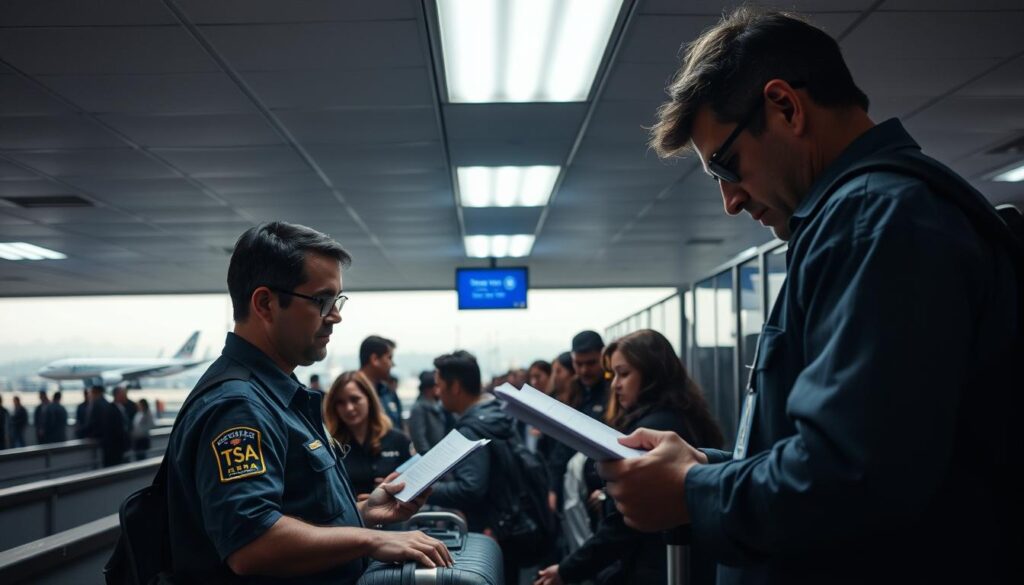
Compliance with FTSP requirements is not just a regulatory necessity, but a critical component of national aviation security. The Transportation Security Administration (TSA) takes the security of flight training operations seriously, and as such, has implemented stringent measures to ensure adherence to the program’s requirements.
Audits and Inspections
The TSA conducts regular audits and inspections to verify that flight training providers and candidates are complying with FTSP regulations. These audits may include reviews of documentation, on-site inspections, and assessments of security protocols. By doing so, the TSA ensures that all flight training activities are conducted in a secure environment.
During these audits, the TSA checks for compliance with various aspects of the FTSP, including candidate eligibility verification, training records, and security awareness programs. Providers must be prepared to demonstrate their compliance with these requirements.
Consequences of Non-Compliance
Failure to comply with FTSP requirements can result in severe consequences for both flight training providers and candidates. Some of the potential consequences include:
- Civil penalties for non-compliance with FTSP regulations, which can be substantial.
- Criminal prosecution in severe cases, particularly for providing false information to the TSA.
- Increased scrutiny for providers who fail to verify candidate eligibility or provide training to ineligible individuals.
- Repeated or willful violations may lead to referral to law enforcement agencies and potentially impact a provider’s ability to continue offering flight training.
Understanding these consequences highlights the importance of thorough compliance with all aspects of the FTSP to maintain aviation security. By adhering to the program’s requirements, providers and candidates can ensure a secure environment for flight training activities.
Privacy and Data Security Considerations
As you navigate the Flight Training Security Program, it’s essential to understand how your personal information is safeguarded. The Transportation Security Administration (TSA) is committed to protecting your information security while ensuring the integrity of aviation security programs.
The TSA adheres to stringent data protection policies, including the Privacy Act, to maintain the confidentiality of the information you provide. This commitment is reflected in the measures taken to secure your data against unauthorized access or breaches.
How Your Information Is Protected
The TSA employs robust security protocols to safeguard your information. These include secure data storage systems and strict access controls, ensuring that your personal information is protected in accordance with federal security standards.
When you undergo a Security Threat Assessment, the information collected is handled with care. The TSA ensures that this information is processed securely and in compliance with relevant privacy laws and regulations.
Data Retention Policies
The TSA maintains specific data retention policies that govern how long different types of information are kept within the Flight Training Security Program systems. For instance:
- Information collected for Security Threat Assessments is retained according to federal records schedules, with varying timeframes based on the type of information and its security relevance.
- Records of completed security assessments are maintained to facilitate recurrent training and to identify patterns of activity that may have security implications.
- The TSA’s retention policies balance security needs with privacy considerations, ensuring that information is not kept longer than necessary for program purposes.
These policies are documented in System of Records Notices and are subject to oversight by privacy officials within the Department of Homeland Security, further ensuring that your information is handled responsibly.
Additional Aviation Security Resources

As part of its mission to secure the nation’s aviation system, the TSA makes available several key resources to support flight training providers and candidates in meeting the requirements of aviation security programs.
Training Materials and Guidance Documents
The TSA provides a variety of training materials and guidance documents to help you understand and comply with aviation security regulations. These resources include detailed guides on the Flight Training Security Program (FTSP), security threat assessment processes, and best practices for maintaining compliance.
By utilizing these resources, you can ensure that you are well-informed about the latest security protocols and regulatory requirements, thereby enhancing the security of flight training activities.
Customer Support and Technical Assistance
The TSA offers dedicated customer support and technical assistance to help you navigate the requirements of aviation security programs. You’ll have access to the FTSP Help Desk, which provides assistance with account creation, application submission, and troubleshooting portal technical issues.
- Subject matter experts are available to answer questions about program requirements, documentation needs, and compliance concerns.
- Support is available through multiple channels, including phone, email, and through the FTSP Portal’s messaging system for secure communications.
- Understanding how to access these support resources helps ensure that questions are answered promptly and issues are resolved efficiently to minimize disruption to flight training activities.
Conclusion For Aviation Programs :
With the knowledge you’ve gained, it’s clear that TSA’s aviation security initiatives play a vital role in protecting the nation’s transportation systems. The Transportation Security Administration’s efforts to secure aviation have led to the development of critical programs such as the Flight Training Security Program, Federal Air Marshal Service, and Federal Flight Deck Officer Program.
These programs are designed to prevent potential security threats from receiving flight training, thereby maintaining the integrity and safety of the aviation community. By understanding and complying with these security requirements, you contribute to the overall safety of flight operations.
The evolution of these programs since 9/11 demonstrates TSA’s commitment to balancing effective security with the practical needs of the aviation industry. As a result, the benefits of these initiatives are evident in the enhanced security measures that protect both flight training and air transportation.
By working together, TSA and the aviation community continue to enhance security while enabling the vital activities of flight training and air transportation to proceed safely and efficiently.
